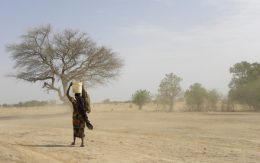This analysis is the second article of a six-part series on the Eastern Mediterranean, which provides an overview of the socio-economic problems in the region, in order to establish an understanding of the current events unfolding in the region. The other parts of this series deal with the historical background, the Arab Uprising, the Syrian Civil War, the Israeli-Palestinian conflict from 2000-2020, and the “problematic” triangle: Turkey, Cyprus, Greece.
While the entrance of the 21st century signalized a shift from a preexisting unpredictability to a new period of stability for the rest of the international system, a similar development did not occur in the Eastern Mediterranean. As Florence Gaub perfectly summarizes, “[the] Eastern Mediterranean is currently at the epicentre of regional upheaval; the last five years have unfolded in the most unpredictable manner, which raises concerns about the five years to come” (ELIAMEP, 2016: 21). Over the last decades, the region has been the stage of large-scale phenomena accompanied by high political unrest, degradation of socio-economic conditions, and the rise of violence. These shifts have created new security threats, proxy wars, and domestic conflicts that have challenged not only the regional authorities but also the international community. Furthermore, the previously existing “status quo” among the states has been disrupted either by expansionist policies of some political leaders and regional conflicts, or the influence of third states and superpowers. However, what renders the situation in the region especially volatile is the interaction and the deep historical roots of the majority of the regional issues. The combination of these factors constitutes their resolution particularly difficult, hence contributing negatively to their persistence and intensification.
After the presentation of the historical background of the Eastern Mediterranean states, the forthcoming parts aim to present the issues and events that have determined the development of the region in the last twenty years. Contrary to the first part, the analyses of the following articles do not focus on the states, but instead, attempt to shed a light on the present numerous, and complicated issues that the region is confronted with. The rationale behind this decision is that contemporary matters and challenges have transcended the national borders, thus rendering a state-centric study limited and narrow. For this reason, the following articles in this series briefly examine a) the socio-economic background evolution of the region, b) the 2010/11 Arab Spring; c) the ongoing Syrian Civil War; d) the Israel-Palestine conflict in the last twenty years; e) the competition of Cyprus and Greece with Turkey. While these are not the only issues the Eastern Mediterranean states are currently facing, they provide a good understanding of the current problems in the region and starting points for further research. This present analysis will start by unpacking the socio-economic challenges the region faces.
The socio-economic problems
Despite being positioned in a quasi-rich land with existing or recently discovered energy deposits, most of the regional countries have suffered severe social and economic challenges. While in some cases the roots of these problems go back to colonial times, in others, they are the result of government corruption, mismanagement of state resources, or even external pressures. It is also important to take into consideration the rise of non-traditional threats, such as climate change, irregular migration, and organized crime. These new types of threats are a two-fold danger: whereas they can impact the ecosystem and have a catastrophic dimension due to possible natural disasters like the 2020 Australian wildfire, they can also facilitate violence by inducing other phenomena such as resource scarcity or drought (e.g., the case of the drought preceding the Syrian Civil War), hence functioning as a sort of threat multiplier (Ullman, 1983). Furthermore, it is crucial to highlight that the countries analyzed in this article do not enjoy the same privileges. For instance, Greece and Cyprus are part of the European Union, while Palestine is not even recognized as an official state. Therefore, considering the above factors and the plethora of domestic and transnational developments at play, the investigation of the socio-economic development of a group of states is very difficult. Yet, it is still necessary for the comprehension of the developments in the last twenty years.
When thinking of a recent economic crisis, the first country that comes to mind of economists and political scientists is Greece, as the state entered a serious public debt crisis in 2010, in the aftermath of the 2007-08 global financial crisis. While the Greek economy presented an ascending projection from 2001-2008, the combination of higher government spending, mounting debt loads, and the consequences of the slowdown in the international economic growth resulted in a huge economic crash. To be more specific, Greece was confronted with numerous fiscal problems and debt which accounted for more than 129.7% of the GDP in 2009 and a fiscal deficit of almost 15.7% of the GDP, much higher than the 3% ceiling set by the Eurozone (Eurostat, 2015). The “grandeur” of the issue caused concerns to its European counterparts, which were afraid of growing borrowing rates, especially for the countries of the European South (Kotios & Roukans, 2013). To avoid this scenario, Greece joined the Tripartite Support Mechanism in May 2010 and lived with stiff austerity measures for years. The impact of the latter has been severe on the Greek population that had to succumb: reductions in public services, social security, or social protection, and unprecedented levels in unemployment, mainly among the younger generation (FIDH, 2014). Apart from that, Greece’s entry into the Tripartite Mechanism did not help the economic situation of the country as it did not show any signs of improvement several years later. The corresponding decision of the EU to impose further restraint brought the two sides to a stand-off in 2015 that almost ended up in Grexit – the exit of Greece from the EU. However, several years after, the situation in Greece seems to look better with the country experiencing ascending growth and budget surpluses in 2020 (Financial Times, 2020).
In the same period, Cyprus faced similar issues as its close neighbour. Despite the accession to the EU in 2004 and the Eurozone in 2008, the GDP of the country faced a descending projection from 2011 until 2016. Like Greece, it was the result of the world economic crisis of 2007-08, its evolution into a Eurozone crisis, and the increased borrowing by Cyprus (Roukans & Galanos, 2016). In May 2013, Cyprus agreed to a Financial Assistance and Adjustment Programme with the European Commission, the International Monetary Fund, and the European Central Bank, which aims to restore financial stability in the Cypriot economy (European Commission, 2017). The program was completed in March 2016 and since then, Cyprus has been expanding rapidly with a robust growth at 4,4%. Still, there are a few ongoing issues, such as the need for more ambitious policies in its export division.
Turkey also presents an interesting case of economic development in the region, which has been recently appearing at the centre of the attention of economists. In the last twenty years, Turkey has been experiencing fluctuating economic growth (Acemoglu, 2016). For example, following a severe financial crisis in 2001, the state experienced rapid economic progress in the next five years, due to esoteric structural changes, an increase of productivity, and a broadening of regional economic relations. But this soon came to end, when the preexisting momentum slowed significantly in 2007. Then again, four years later, Turkey’s institutional changes signalized another period of positive economic development. Yet, it did not manage to avoid the Turkish currency and debt crisis of 2018 as the Turkish lira plunged in value, thus leading to high inflation, borrowing costs, and loan defaults. Despite the ongoing fluctuations, Turkey not only remains the country with the highest GDP in the region (World Bank, 2019), but also it has achieved amazing progress in infrastructure, technology, and energy in a short time (Oxford Business Group, 2015). However, the constant devaluation of the Turkish lira in the last years, combined with the growing rate of unemployment and Erdogan’s populism could seriously damage the prospects of the country.
When it comes to Israel, the macroeconomic analysis is much different from the preceding two cases. While the state faced a recession in the late 2000s, in the last decade, it has proven to be one of the most resilient and technologically advanced market economies in the region. Indicatively, Israel has not only been ranked repeatedly among the world’s top economies but also over the last three years, it has consistently positive figures: GDP, GDP per capita, GDP growth, inflation rate, unemployment rate, and government debt (IMF, 2020). It is thus safe to assume that it will follow an ascending trajectory in the years to come. This cannot be said for Palestine that has been severely hit by the Covid-19 pandemic. Before the coronavirus, the Palestinian authorities (PA) have been confronted with a series of problems, mostly stemming from the hostile actions of Israel. For instance, in 2012, EU activists brought to the attention of the global community that the Palestinian economy “lost access to 40% of the West Bank, 82% of its groundwater and more than two-thirds of its grazing land” because of the occupation and settlement construction (Sydow, 2012). In the next years, the PA survived through Saudi budgetary support, Qatar’s financial aid, and generally, the support of Gulf Arab states (Carnegie, 2020). However, the current coronavirus outbreak has been a “nail in the coffin” to the already problematic and limited economy of the PA. The plunging oil prices have revealed the negative consequences of PA’s high level of dependency as the economy has been in a free fall since 2018. On top of that, the lack of both policy space and economic tools to deal with issues of such size has further intensified the preexisting gloomy problems and scenarios (UNCTAD, 2020).
Jordan is another country that has been recently experiencing economic challenges. While at the beginning of the century, the country was proclaimed to be a model for the region, a plethora of issues have resulted in the accumulation of 42 billion in public debt (Reuters, 2019). This development is the result of a range of factors: a) successive government pursuing expansionist fiscal policies for the creation of jobs in a bloated public sector; b) past governments over-spending on welfare and public sector to tackle the domestic protest following Arab Spring in 2011; c) the rise of the unemployment rate; d) regional conflicts that have hindered demand and economic investment. As a result, the state was forced to implement reforms and subsequent fiscal consolidation policies under the terms of the extended fund facility that it negotiated with the IMF in 2016. Since then, the situation has improved (for example, IMF estimates the government debt to be 94.6 in 2019 and to decrease to 94.1 in 2020 and 92.4 in 2021), and Jordan renewed its agreement with the IMF in 2020. However, the outbreak of Covid-19 could potentially diminish the rate of recovery and the speed of the Jordan economy (IFPRI, 2020).
Going further in our analysis, a closer examination reveals that there are some patterns or negative phenomena, which most of the regional states experience, such as high dependency on energy resources and foreign investment, high unemployment rate, and big state spending causing huge amounts of public debt. Moreover, some East-Med states do not follow a steady course of development but instead, experience sporadic fluctuations. An excellent example demonstrating this is Lebanon. Following the end of the civil war (for reference, see Part I), the state enjoyed rapid economic growth because of the huge numbers of financial aids, investments, and tourists (Mayton, 2007). Despite the month-long 2006 war and the 2008 economic crisis, Lebanon ranked as the world’s best performer in the 2008 MSCI index (Morgan Stanley Capital International Index)(Kathryn, 2008) and continues to show an ascending trajectory over the next years. For instance, the IMF released a report in April 2015, which estimated Lebanon’s economic growth rate at 2% (IMF, 2015). In the last years, this positive momentum has come to a halt with catastrophic results. In October 2019, Lebanon witnessed nationwide protests that erupted over the country’s deteriorating economic conditions (BBC, 2019). The combination of wildfires, a shortage of foreign currency, and high taxation caused public outrage (Financial Times, 2019). Although responding with a recovery plan, this measure did not prove efficient because political sectarianism and groups looking after their interests (a result of deep division caused by past longstanding civil war) hindered the possibilities of the resolution of the socio-economic problems of the country. The situation further escalated in April 2020 when a young man was shot dead by soldiers during a violent protest in Tripoli, Lebanon. But the recent explosion of 2,750 tons of ammonium nitrate at the port of Beirut led to international and domestic protests concerning the overall state of affairs in Lebanon (BBC, 2020). While the explosion was a cataclysmic event, it has also shown the problems and the deterioration of internal conditions, thus paving the way for improvements and future progress.
The remaining two countries are Egypt and Syria. As the latter is better analyzed in part three of this series, this section focuses on Egypt, which has experienced a “rocky” development over the last twenty years. In the first decade, the fiscal, monetary, taxation, and privatization reforms managed to move forward the economy and prompt foreign investments. In parallel, the market-oriented reforms failed to equitably share the wealth and benefits of the growth, hence broadening the already existing domestic problems, such as growing rates of unemployment and underemployment (Mahdi, 2011). On top of that, the eruption of the global financial crisis in 2008 further deteriorated and sped up the underlying domestic issues. The soaring food prices and the long-term supply- and demand-side repercussions brought the national economy to its knees. That, combined with the effects of Arab Spring, resulted in the overturn of the preexisting president, Hosni Mubarak, and the initiation of a period of unrest that lasted until 2014. The social unrest provoked rating agencies to lower the country’s credit rating on several occasions, as they were sceptical of the country’s ability to meet its financial targets (S&P, 2012). To tackle the constantly deteriorating economic conditions, the Egyptian government embarked on a homegrown economic reform program supported by a $12 billion IMF loan, in a bid to restore macroeconomic stability and growth (IMF, 2018). This decision combined with an upswing in tourism, strong remittances from Egyptian workers abroad and recently discovered natural gas fields coming onstream proved to be sufficient to boost Egypt’s economy in the last three years (Reuters, 2020).
Based on this overview of the socio-economic problems in the Eastern Mediterranean, the forthcoming third part of this series provides an analysis of the Arab Uprising of 2010/11 in the region.









Be First to Comment